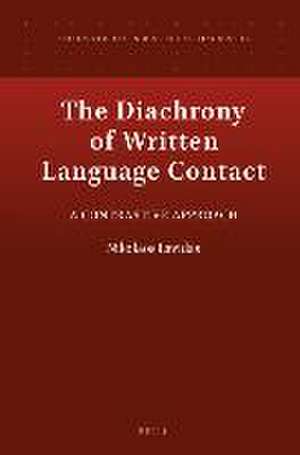The Diachrony of Written Language Contact: A Contrastive Approach: Brill's Studies in Historical Linguistics, cartea 15
Autor Nikolaos Lavidasen Limba Engleză Hardback – 15 dec 2021
Din seria Brill's Studies in Historical Linguistics
- 18%
 Preț: 606.42 lei
Preț: 606.42 lei - 18%
 Preț: 640.08 lei
Preț: 640.08 lei - 18%
 Preț: 659.44 lei
Preț: 659.44 lei - 18%
 Preț: 832.88 lei
Preț: 832.88 lei - 18%
 Preț: 767.41 lei
Preț: 767.41 lei - 18%
 Preț: 694.47 lei
Preț: 694.47 lei - 18%
 Preț: 734.01 lei
Preț: 734.01 lei - 18%
 Preț: 753.78 lei
Preț: 753.78 lei - 18%
 Preț: 705.21 lei
Preț: 705.21 lei - 18%
 Preț: 627.48 lei
Preț: 627.48 lei - 18%
 Preț: 683.88 lei
Preț: 683.88 lei - 18%
 Preț: 676.34 lei
Preț: 676.34 lei - 18%
 Preț: 556.28 lei
Preț: 556.28 lei - 18%
 Preț: 607.27 lei
Preț: 607.27 lei - 18%
 Preț: 630.13 lei
Preț: 630.13 lei - 15%
 Preț: 472.77 lei
Preț: 472.77 lei
Preț: 704.35 lei
Preț vechi: 858.96 lei
-18% Nou
Puncte Express: 1057
Preț estimativ în valută:
134.80€ • 139.54$ • 113.93£
134.80€ • 139.54$ • 113.93£
Carte indisponibilă temporar
Doresc să fiu notificat când acest titlu va fi disponibil:
Se trimite...
Preluare comenzi: 021 569.72.76
Specificații
ISBN-13: 9789004463752
ISBN-10: 9004463755
Dimensiuni: 155 x 235 mm
Greutate: 0 kg
Editura: Brill
Colecția Brill
Seria Brill's Studies in Historical Linguistics
ISBN-10: 9004463755
Dimensiuni: 155 x 235 mm
Greutate: 0 kg
Editura: Brill
Colecția Brill
Seria Brill's Studies in Historical Linguistics
Cuprins
Acknowledgements
List of Figures and Tables
1 Written Language Contact and Translations
1.1Terminology of Language Contact
1.2Written Language Contact
Acknowledgements
2 Early History of Translations and Grammatical Change: Landmarks in the Development of Early Translations
2.1Early History of Translations and Grammatical Change in English
2.2Greek in Written Contact: History of Early Translations
3 Biblical Translations
3.1The Corpus of Biblical Translations: Source of Evidence of Grammatical Change
3.2Biblical Translations as Factor of Grammatical Change
3.3English Biblical Translations: Examples of Corpus-Based Surveys
4 Intralingual Translations: Two Directions—to the Past or to the Present
4.1Introduction
4.2Intralingual Translations as Evidence of Grammatical Change
4.3Types of Greek Intralingual Translations
4.4Retranslations and Their Relation to Intralingual Translations
5 Examples of Studies on Grammatical Change in English through Translations
5.1Translations and Multilingualism in the History of English
5.2Grammatical Characteristics and the Effect of Other Languages in the Diachrony of English
6 From Syntactic Diglossia and Universal Bilingualism to What Diachronic Translations Can Tell Us about Grammatical Multiglossia
6.1A Theoretical Proposal: Grammatical Multiglossia
6.2Historical Grammatical Multiglossia, L2 and Bilingualism
6.3Historical Grammatical Multiglossia and Ferguson’s Diglossia
6.4Historical Grammatical Multiglossia as Related to (Seminatural Change
7 English Data
7.1Voice, Argument Structure and Transitivity in English Biblical Diachronic Retranslations
7.2Voice and Transitivity in English Diachronic Biblical vs. Non-biblical Translations
7.3English Biblical vs. Non-biblical Diachronic Retranslations: Borrowing of Word-Formation Morphology
8 Greek Data
8.1Greek Diachronic Retranslations of the New Testament: Voice and Argument Structure
8.2Greek Diachronic Retranslations: Phrase Matching Approach
8.3Greek vs. English Data: An Approach to the Diachrony of Written Language Contact
9 Conclusion
Appendix 1: Further Information on the Texts of the Corpus (I–II)
Appendix 2: (i) The Corpus of Translations of Biblical Texts; (ii) The Corpus of Translations of Boethius’ De Consolatione Philosophiae
References
Index
List of Figures and Tables
Part 1 Written Language Contact and Grammatical Change in English and Greek
1 Written Language Contact and Translations
1.1Terminology of Language Contact
1.2Written Language Contact
Acknowledgements
2 Early History of Translations and Grammatical Change: Landmarks in the Development of Early Translations
2.1Early History of Translations and Grammatical Change in English
2.2Greek in Written Contact: History of Early Translations
3 Biblical Translations
3.1The Corpus of Biblical Translations: Source of Evidence of Grammatical Change
3.2Biblical Translations as Factor of Grammatical Change
3.3English Biblical Translations: Examples of Corpus-Based Surveys
4 Intralingual Translations: Two Directions—to the Past or to the Present
4.1Introduction
4.2Intralingual Translations as Evidence of Grammatical Change
4.3Types of Greek Intralingual Translations
4.4Retranslations and Their Relation to Intralingual Translations
5 Examples of Studies on Grammatical Change in English through Translations
5.1Translations and Multilingualism in the History of English
5.2Grammatical Characteristics and the Effect of Other Languages in the Diachrony of English
6 From Syntactic Diglossia and Universal Bilingualism to What Diachronic Translations Can Tell Us about Grammatical Multiglossia
6.1A Theoretical Proposal: Grammatical Multiglossia
6.2Historical Grammatical Multiglossia, L2 and Bilingualism
6.3Historical Grammatical Multiglossia and Ferguson’s Diglossia
6.4Historical Grammatical Multiglossia as Related to (Seminatural Change
Part 2 Data: English and Greek Translations and Grammatical Change
7 English Data
7.1Voice, Argument Structure and Transitivity in English Biblical Diachronic Retranslations
7.2Voice and Transitivity in English Diachronic Biblical vs. Non-biblical Translations
7.3English Biblical vs. Non-biblical Diachronic Retranslations: Borrowing of Word-Formation Morphology
8 Greek Data
8.1Greek Diachronic Retranslations of the New Testament: Voice and Argument Structure
8.2Greek Diachronic Retranslations: Phrase Matching Approach
8.3Greek vs. English Data: An Approach to the Diachrony of Written Language Contact
9 Conclusion
Appendix 1: Further Information on the Texts of the Corpus (I–II)
Appendix 2: (i) The Corpus of Translations of Biblical Texts; (ii) The Corpus of Translations of Boethius’ De Consolatione Philosophiae
References
Index
Notă biografică
Nikolaos Lavidas is Assistant Professor of Linguistics at the Department of Language and Linguistics, Faculty of English Language and Literature, National and Kapodistrian University of Athens. His research interests lie in the areas of language change, historical linguistics, syntax-semantics interface, argument structure, (historical) language contact and historical corpora.
